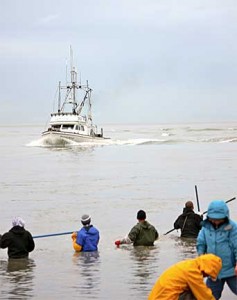
Catching salmon on the Kenai River is a bloody, slimy art. You have to be resistant to cold, rain, sand, fish entrails, and huge crowds. As an East Coaster new to “the Last Frontier,” I was completely unprepared for my first dipnetting experience.
Dipnetting salmon in Alaska is akin to…well…nothing comes to mind. In my neck of the woods, fishing is something people do for pleasure. You come home at the end of the day with a fresh sunburn and some sand in your hair, and if you catch a few fish to eat all the better. Not so in the great North.
Instead of fishing for salmon with a traditional fishing rod, which wouldn’t work because salmon are no longer eating as they swim upstream to have their babies and die, some Alaskans do something called dipnetting. Dipnetting is when you stand in the water wearing waders holding a 5 foot diameter net, wait for a salmon to swim into it, and then drag it back onto shore and kill it by bonking it in the head. I’m pretty sure that’s a technical term, and it’s usually the kid’s job.
Dipnetting is a family affair. I felt as if I were entering a festival or carnival; the shore is covered with tents, fires, beach chairs, and coolers of food. Adults convene around the fire for a beer in between “hot” times of the fishing run while kids run around and make sculptures out of fish heads. There is a spirit of free-for-all in the air, but everything switches the instant the salmon start to run “hot” again. Beers are dropped, nets dragged to the water, and kids stand at the ready to bonk start bonking. Once the salmon shivers, signifying that its brain is sufficiently bashed, the fish is ready for processing.
Warning: Video shows graphic depiction of salmon “bonking.” Watch at your own risk.
Processing is the hardest, and goriest, part of fishing. First, salmon is de-gilled to bleed it out. This is necessary to ensure the freshest possible flavor. The fish should then be slit from anus to gills, and all the entrails thrown out. The kidney, a dark line of black, clotted goo along the salmon’s spinal cord, also has to be washed out. The fish is de-slimed, de-sanded and de-headed, and cut into juicy, bright-red fillets. The most ambitious and skilled dipnetters filet their salmon right on the beach, unfazed by the general chaos.
Time is of the essence in this process, because the faster the fish can be prepared and thrown on ice the better the flavor will be. Unfortunately, when people throw the entrails and heads of their salmon back in the ocean, they wash up on the shore during high tide. The beach begins to resemble a battlefield and seagulls are in heaven.
As we hadn’t come to the beach as prepared as most, we chose to take the salmon back and process it in the comfort of our backyard. I was relieved to leave behind the frenzy of the beach, naively believing that the hardest part of dipnetting was over. After 6 hours of vacuum packing we were only halfway done with our fish, and I was beginning to wonder if these salmon were really worth all the trouble. That night, hungry and exhausted, we grilled our first salmon. It was worth it.
Click here for the recipe for Cedar Plank Grilled Salmon with Dave’s Spicy Brown Sugar Rub, via laurieconstantino.com.
Catherine Lamb is an accomplished baker and student of Art History and French at Williams College in Massachusetts. She is an Atlanta native, and just returned from a year abroad in France. She is currently spending the summer in Alaska. You can read more of her writing at her blog, L’Americaine Gourmande.




